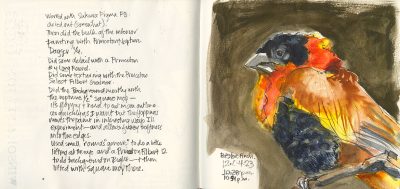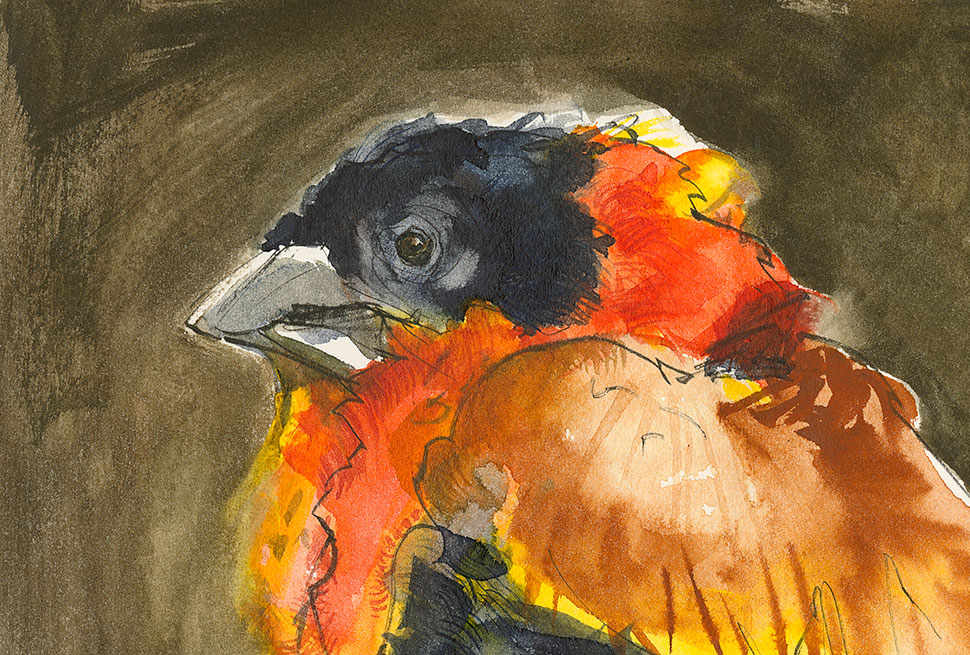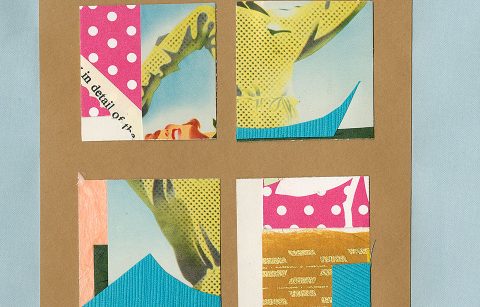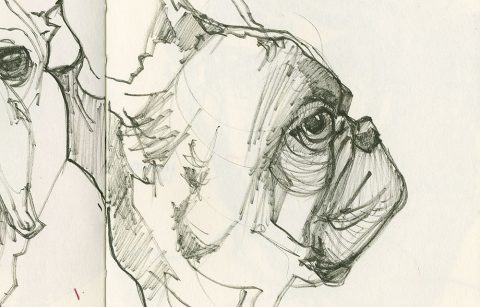
Now and then I get a desire to test something new. Sometimes I hear about a new product, or a friend mentions something to me. Sometimes I go to the store and see something and wonder what it would be like to use that tool or medium.
Other times, like recently, I unpack brushes that have been stored for over 4 years and find a host of brushes I bought for a project and didn’t get around to using.
The Dagger Brushes have surfaced.
So I tested them, and for most of December and January I used them almost exclusively. And I cycled through different brands trying to find one that reacted in a way I found most useful and most joyful.
I wrote about my first trial with the Neptune brushes in my December 6, 2023 blog post. That post also includes a link to my stroke tests with a bunch of daggers from different lines. If you haven’t checked that out, I suggest you follow the link.
Refresher—What’s a Dagger Brush?
It’s a brush that is shaped like a dagger or a sword. It’s wide at the ferrule with one flat edge extending out and then the second edge curves from the ferrule to the tip—giving the brush a dagger/sword profile. (There are actually brushes called sword brushes. They tend to be longer and floppier, and seem to be favored by calligraphy artists and those car detailers painting pinstripes and swirls on cars.)
I wanted to use them with watercolors. They can hold a lot of paint and that appealed to me.
What didn’t appeal to me was ultra soft (and hard to control because they are floppy) brushes.
You have to get a good head of steam going and keep going to keep them in line. Or not, and then accept the consequences of your indecision and the resultant blobs and splotches.
But I’m game for testing so I test I did. Several of my paintings were taped and you’ll see them mostly on Patreon in the next couple of months, or on YouTube (I haven’t decided which I want to use where). I won’t show any of them on my Instagram because the small frame in that format won’t really let you see what I’m doing with the brush.
What I will do, is post some stills here on RWU and some comments about the various lines I tried.
Check back often, as the series will appear intermittently as I process the material.
My Second Test
Today’s finch is my second test with the Neptune dagger. However, if you read the handwritten text on the page spread you’ll learn that I switched out to other brushes to do other work throughout the bird. So I don’t see the Neptune dagger being an all purpose brush for me.
Most people would say, why would you even try to make it so? And I’d reply, “I’m a lazy painter. I get a brush or pen in my hand and I just keep going, and rarely switch out. It’s a force of habit from all those decades sketching out in public, wanting to hold only a few things in my hands as possible. Can I retrain myself? Yeah, sometimes in the studio I come close to retraining myself, but at this stage of the game, as the Magic 8 Ball would tell you, “Outlook not so good.”
A Couple of Tips that Aren’t Tips, Just Realities
If you like firm, stiff brushes the Neptune daggers are going to seem very loose to you.
First off—if you work from pan watercolors, and I do when I’m out and about so I did all my tests with pan watercolors—it’s a pain to pick up color on a 1.5 inch brush from a 1/2 pan.
If you don’t know what I’m talking about you don’t use 1/2 pans, and you don’t need to worry about this. If you do know what I’m talking about you might want to move along to a stiffer brand ASAP and skip the Neptune line altogether.
You aren’t going to want to jam the tip in a pan (If you lose the tip of this brush you might as well be painting with a make-up brush), and you aren’t going to want to bend the body which is also hard on the hairs. Picking up color to totally fill the brush can be done with pans but really saturate those pans with water and let them sit for 5 to 10 minutes so it’s an easy, no scrubbing pick up.
And be prepared to pick up adjacent colors from additional pans on the long brush, either at the ferrule or tip end—whichever extends outside of the pan as you stroke to get color.
Rather than being irritated by this reality I say embrace it and have fun with it. It’s like double charging your brush, without thought.
And you probably have your paints arranged in some sort of color wheel order that puts analogous colors next to each other so you’ll be right. No worries.
More important is working out how to get saturated color into the brush. The color has to be liquid enough to be picked up by the brush, but once you get to a certain level of saturated color it’s more difficult to pick that color up uniformly in the brush that is so floppy. Again it can be done—I got it in this second painting. Remember you’ll just need to work with it for a bit. Maybe you’ll get it in the first painting, the second…it doesn’t matter, if you have a reason for wanting to use the brush the learning process in each painting will teach you more.
It taught me that it was time to move on to stiffer options.
The Case for Drawing From Life
Because of current health issues I’m housebound and today’s featured sketch was painted from a photo I took years ago at a Pet Store (yes the one I was banned from, and I was totally innocent!).
I bring this up because I really would like to test all the daggers I’ve used so far in the field.
For me there is something so totally different about the choices you can and do make in the field.
I have a feeling in my gut, that I know is right, that if I were able to test these brushes in the field I might like them all better than I do at the present moment.
Why? Because it doesn’t matter how fast I work in the studio, the subject isn’t going anywhere. As much as I try to replicate a “life” situation, there is something in one’s physical response that reminds you, even faintly, that not as much is at risk.
I believe that in working fast to catch the live subjects I would probably work with direct brush and even though I do that in my studio tests which you’ll see another day, it would be markedly different.
In the process of working directly with THIS brush, from life, in public, I would be forced to accept and use a range of marks wholly unknown and unexpected by me.
And that would be a great and joyous day, even if all the sketches were less that readable or interesting or lifelike.
I also believe that in that move to bend the brush to mark making that would help me capture a live person, or buffalo, or penguin, I would come upon a new way of economical mark making that would intrigue and dazzle me.
Even if the results only confused you, and caused you to wonder if I was alright!
Those moments of risky drawing from life have given me all that and so much more in the past. There is every reason to expect they would do it again with this unusual (to me) brush.
And those risky moments and dazzling self epiphanies are why I encourage you to draw from life in public all the time, and why I miss it so much. I learn more from a live subject in public session than I do from hours and hours of perfect likeness in-studio sketching.
Will I return to the Neptune Daggers?
I suppose now is a good time to quote Sir Sean Connery and say, “Never say never.”
But in reality I think the only reason I would pick one of these up would be to make interesting linear and splotchy textures for backgrounds perhaps. Or for calligraphy. Or for trees and foliage. Trees and foliage will always benefit from the use of this type of brush!
I’ll discuss other brush lines in a future post…























Love seeing birds “migrate” back into your sketchbook! It’s a great opportunity to use more of those bright cheery colours👍.
In my heart I’m hoping I can go to the Fair this year and sketch chickens, so I need to get back in the groove!
I totally agree about choosing different tools and having different needs in the field. That’s really when I want a do-everything, versatile tool.